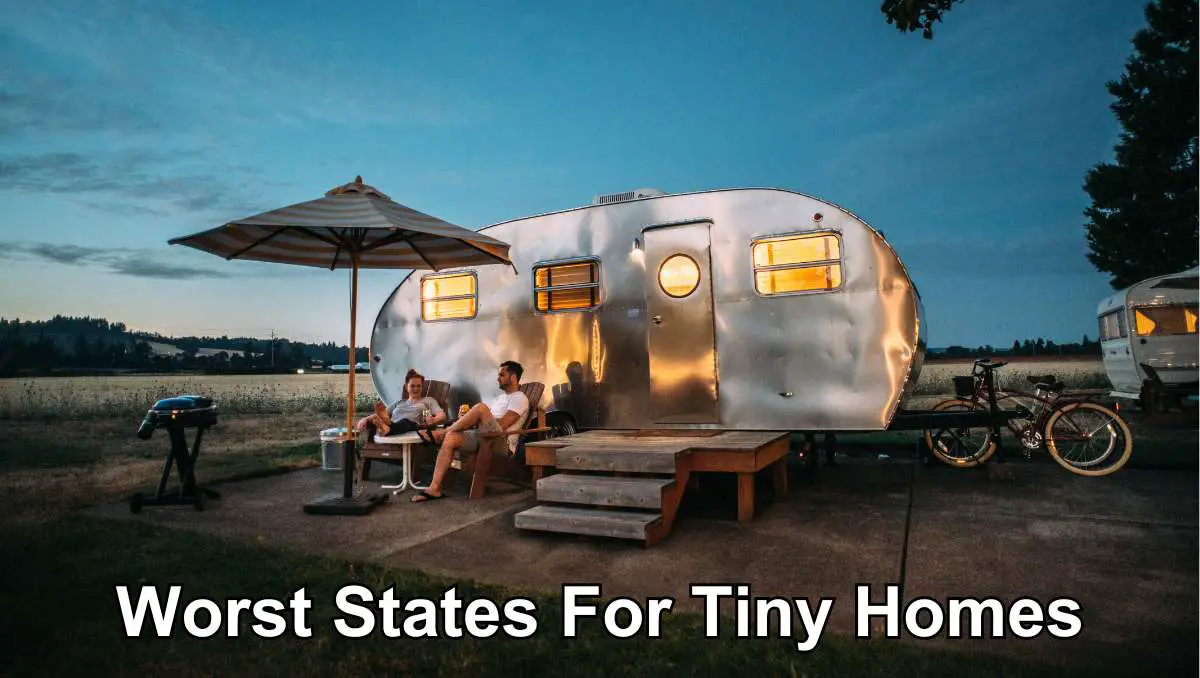Are you dreaming of a simpler, more affordable lifestyle in a cozy, tiny home? Before you start designing your mini-abode, it’s crucial to consider the laws and regulations in your chosen state. Unfortunately, some states are worst and not welcoming to the tiny house movement. Some can be downright inhospitable.
The worst states for tiny homes include New York, Rhode Island, Arkansas, Connecticut, Hawaii, Alaska, California, and Illinois due to their strict zoning regulations, high land costs, and limited availability of suitable tiny home communities.
In this article, we will explore the eight worst states for tiny homes – those places where restrictive regulations make it nearly impossible to enjoy the benefits of compact living.
8 Worst States For Tiny Homes
If you’re considering living in a tiny home, think twice about settling down in New York, California, and other states we will discuss below. The state presents several regulatory hurdles and space constraints that can make it difficult for tiny homeowners to find suitable locations.
New York: Regulatory Hurdles and Space Constraints

Despite its reputation as a bustling hub for innovation and creativity, New York poses significant challenges for tiny home enthusiasts due to strict regulations and limited available space. Tiny homes are not allowed as permanent residences in New York and can only be used as temporary housing in certain areas.
With only 0.02% of the state’s land area suitable for tiny home construction, finding an appropriate location can be extremely difficult. Regulatory obstacles such as housing codes and building permits further add to the hurdles faced by those looking to embrace the tiny home lifestyle in the Empire State.
Not only do these regulations make it harder to find suitable land, but they also increase the overall cost of constructing a tiny home. The limited space and high population density in New York exacerbate these issues, making finding affordable land for tiny homes even more challenging.
Despite these challenges, innovative individuals continue to explore alternative solutions and advocate for changes that would make it easier to incorporate tiny homes into New York’s housing landscape.
California: Zoning Challenges and High Costs
California presents its own unique set of challenges for tiny home enthusiasts. Zoning restrictions and exorbitant costs make it difficult to find suitable locations and affordably build these compact dwellings.
The stringent zoning regulations in many areas limit where tiny homes can be placed, often requiring them to be located on a permanent foundation or within designated RV parks. This restricts the flexibility and mobility many desire when choosing a tiny home lifestyle.
Additionally, California’s high cost of land further adds to the affordability issues faced by those looking to build a tiny home. Building codes can also pose a challenge, as they may require specific minimum square footage requirements that are not conducive to the tiny home movement.
Despite these hurdles, there is still community resistance and skepticism towards alternative housing options like tiny homes, making it even more challenging for enthusiasts in California to find acceptance and support for their chosen way of living.
Illinois: Regulatory Barriers and Urban Focus

Illinois’s strict regulations and focus on urban development make it challenging for tiny home enthusiasts to find suitable locations and pursue their dream of alternative housing. The state’s regulatory barriers create hurdles for those looking to build or park their tiny homes outside designated areas.
Zoning restrictions often classify tiny homes as recreational vehicles, limiting their location and making it difficult to find communities that welcome this form of living. Illinois’s urban focus also means that available land is often reserved for larger developments, leaving little space for tiny home communities. This can be disheartening for individuals seeking a sense of belonging within a like-minded community.
Moreover, Illinois has cold winters, making tiny homes challenging. It is also prone to flooding, posing a safety hazard for tiny home dwellers.
Despite these challenges, dedicated individuals in Illinois continue to advocate for changes in zoning laws and work towards creating more opportunities for tiny home living in the state.
Connecticut: Tiny Home Struggles in the Constitution State
If you’re an aspiring tiny home dweller in Connecticut, you’ll encounter significant challenges due to strict regulations and a lack of available land for this alternative housing option. The Constitution State struggles with zoning and building codes that make finding suitable locations for tiny homes challenging.
Tiny homes can only be used as temporary housing for up to 180 days per year in Connecticut. Additionally, Connecticut’s high cost of living poses affordability issues for those looking to embrace the minimalist lifestyle. Community acceptance is another hurdle, as some residents may view tiny homes as eyesores or question their impact on property values.
Moreover, space limitations can be a significant obstacle when fitting all your belongings into a small living area. Despite these challenges, dedicated individuals are still working towards finding solutions and advocating for more inclusive policies that support tiny home living in Connecticut.
Arkansas: Hurdles in the Natural State

Despite its natural beauty, Arkansas faces challenges regarding the acceptance and regulations surrounding alternative housing options like tiny homes.
Arkansas has strict zoning regulations that often hinder the development of tiny homes. Many areas have specific minimum square footage requirements for residential properties, making it difficult for individuals interested in living in smaller spaces. Additionally, the costs associated with meeting these regulations can be overwhelming for those looking to build or purchase a tiny home.
Furthermore, Arkansas has an urban focus, which means there is less emphasis on supporting alternative housing options like tiny homes. The state’s policies and resources tend to prioritize more traditional forms of housing.
Arkansas is also prone to tornadoes, posing a safety hazard for tiny home dwellers.
Overall, Arkansas presents significant hurdles for individuals interested in living in tiny homes due to its strict regulations, high costs, and urban-focused policies. Despite its natural beauty, finding acceptance and support for this alternative housing option can be challenging within the Natural State.
Rhode Island: Tiny Home Challenges in the Ocean State
Rhode Island’s picturesque coastline and charming towns create a scenic backdrop. However, navigating the regulations and costs surrounding alternative housing options like tiny homes can be challenging in the Ocean State.
Rhode Island is known for its oceanfront living, making it an attractive destination for those seeking a simpler, more sustainable lifestyle. However, building restrictions and zoning limitations present obstacles for tiny home enthusiasts.
The state has specific regulations dictating minimum square footage requirements and foundation specifications, making it challenging to find suitable land or structures to accommodate tiny homes.
Rhode Island law prohibits tiny homes as permanent residences, allowing them to be used as temporary housing for up to 180 days per year.
Additionally, local zoning laws can restrict where these homes can be located, limiting options for aspiring tiny homeowners. Despite these challenges, Rhode Island’s tight-knit community of alternative housing advocates continues to push for change and find creative solutions to make tiny living a reality in the Ocean State.
Alaska: Remote Living, Remote Challenges

Living remotely in Alaska can present unique challenges you may not have considered. While the allure of untouched wilderness and breathtaking views might draw you to this rugged state, certain obstacles come with living off the grid.
One of the leading remote challenges is navigating through regulatory hurdles. Alaska has strict regulations regarding building and zoning, making it difficult for tiny home enthusiasts to find suitable land or obtain necessary permits.
The harsh winters in Alaska can also make tiny homes difficult to live in. Alaska has a high risk of natural disasters, such as earthquakes and floods, which can pose a safety hazard for tiny home dwellers.
Additionally, space constraints can be a significant issue in such a vast and sparsely populated state. Finding available land with proper infrastructure for tiny homes can be daunting.
However, if you’re willing to put in the effort and overcome these zoning challenges, living remotely in Alaska can offer an unparalleled sense of freedom and connection with nature.
Hawaii: Paradise with Regulatory Complexities
Although Hawaii is often seen as a paradise, its regulatory complexities can challenge those looking to settle down in this tropical state. Regulatory obstacles and zoning difficulties can make finding suitable land for tiny homes challenging. The high costs associated with housing in Hawaii only add to the complexity of this situation.
Paradise complexities are not limited to the stunning beaches and lush landscapes; they extend to the intricate rules and regulations that govern building and living in this beautiful place. Hawaii has strict regulations regarding housing limitations, which can be a significant hurdle for those seeking the freedom and simplicity that tiny homes offer.
Limited availability of land and restrictions on size and design make it hard for individuals or families who want to downsize their lives and live more sustainably.
Furthermore, the high living costs in Hawaii pose another challenge for tiny home enthusiasts. The already expensive real estate market and additional fees associated with building permits, utilities, and maintenance make it financially burdensome to establish a tiny home in this paradise.
Which States Do Not Allow Tiny Homes?

If you dream of owning a tiny home, you might be disappointed to learn that there are several states in the US where they aren’t allowed. These states have legal restrictions, building codes, minimum square footage requirements, zoning regulations, and permit requirements that make it difficult or impossible to own a tiny home.
In retrospect, there are no US states where tiny homes are entirely illegal. However, some states have restrictive laws and regulations that make living in a tiny home full-time difficult or impossible. These states include:
- Alaska
- Arkansas
- Connecticut
- Delaware
- Illinois
- Iowa
- Hawaii
- Kentucky
- Louisiana
- Maryland
- Mississippi
- Missouri
- Montana
- New York
- New Jersey
- North Dakota
- Ohio
- Oklahoma
- Rhode Island
- Virginia
- West Virginia
- Wyoming
While these states may not currently allow tiny homes, it’s important to note that regulations can change over time. As the popularity of tiny homes continues to grow, there may be opportunities for advocacy and policy changes that make it easier for individuals to embrace this alternative lifestyle in even the most restrictive states.
Factors to Consider When Choosing a State for Tiny Living
When considering a state for tiny living, there are several key factors that you should take into account.

Legal Considerations
Tiny home legal considerations should be thoroughly examined before purchasing or building. Regulatory restrictions, legal restrictions, building codes, zoning laws, and the permitting process are all critical factors to consider.
Each state has its own set of regulations regarding tiny homes, so it’s crucial to research and understand these laws before making any decisions. Some states have strict building codes that may limit the design and size of your tiny home, while others have zoning laws that restrict where you can place it.
Additionally, the permitting process can vary significantly from state to state, with some states requiring multiple permits and inspections.
Cost of Land and Housing
In the world of tiny homes, finding affordable alternatives is essential. One option is looking for land in areas with lower property prices. Rural locations often offer more land availability at a fraction of the cost compared to urban areas. This not only provides an opportunity to create your ideal tiny home, but it also allows for a peaceful and serene lifestyle away from the hustle and bustle of city living.
Sustainable solutions such as solar panels and rainwater harvesting can further reduce expenses in the long run. Incorporating these elements into your tiny home design can help you achieve self-sufficiency while minimizing ongoing costs.
Overall, it is best to explore affordable alternatives, consider rural locations, and opt for sustainable solutions for tiny home.
Access to Amenities and Services
Access to healthcare is an essential aspect that tiny home dwellers consider when choosing their location. Living in states with excellent healthcare systems ensures that medical needs are quickly addressed.
Transportation options also play a vital role in the decision-making process. Proximity to public transportation or major highways allows for easy commuting and exploring nearby areas.
Educational opportunities are another factor to consider, as access to quality schools and universities is vital for families with children or individuals seeking personal growth.
Recreational facilities provide relaxation and physical activity opportunities, while grocery stores and shopping options ensure that daily necessities are within reach.
Climate and Location Suitability
Climate suitability is a crucial factor to consider when choosing the ideal location for your tiny home. Different regions have varying weather patterns and environmental factors significantly impacting daily life.
When it comes to weather considerations, you want to find a place where the climate aligns with your preferred temperature range. If you enjoy warm weather all year round, states like Florida or California may be more suitable for you. On the other hand, if cooler temperatures are more appealing, states like Colorado or Oregon might be a better fit.
In addition to temperature, other environmental factors should also be taken into account. For example, if you enjoy outdoor activities such as hiking or skiing, living near mountains or national parks would be beneficial.
Where is the Best State for Tiny Homes?
If you’re looking for the best state for tiny homes, you’ll be interested to know that Oregon has the highest number of tiny home communities per capita in the United States. Other best states for tiny homes include Texas and Colorado.

Not only is it a beautiful state with stunning landscapes and diverse climates, but Oregon also offers a welcoming environment for those seeking an affordable housing option in the form of tiny homes.
Oregon stands out as the best state for tiny homes because of its progressive and accommodating regulations. The state has taken steps to simplify zoning restrictions and allow for more flexibility when building and living in tiny homes. This means that individuals who embrace this lifestyle can do so without unnecessary obstacles.
Moreover, Oregon boasts strong community support for tiny home dwellers. Numerous organizations and advocacy groups are dedicated to promoting and supporting this alternative housing option. These communities provide resources, education, and connections that can help newcomers navigate any challenges.
If you’re considering transitioning into the world of tiny living, Oregon should be at the top of your list. Its favorable regulations, affordable housing options, vibrant communities, and beautiful surroundings offer everything you need to make your dream of living in a tiny home a reality.
Charting Your Tiny Home Journey: Tread Carefully
As we’ve explored the worst states for tiny homes, it’s clear that not all states are created equal when embracing the tiny house movement.
It’s important to note that the challenges outlined in this article shouldn’t deter those passionate about tiny living. Ultimately, tiny homes’ best or worst state depends on individual preferences and priorities.
While some states may present formidable challenges – with perseverance, research, and resourcefulness, your vision of a simpler, more sustainable lifestyle can be realized.







